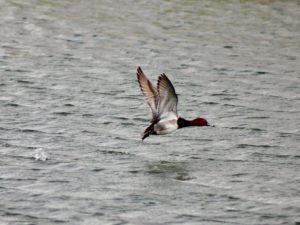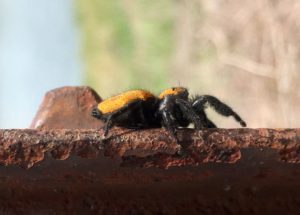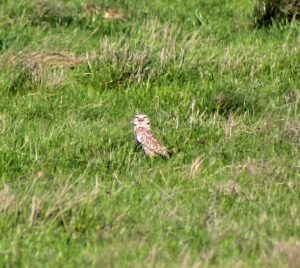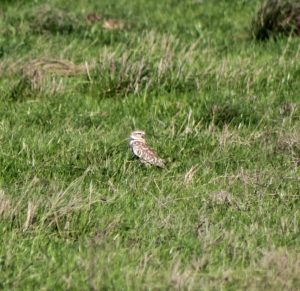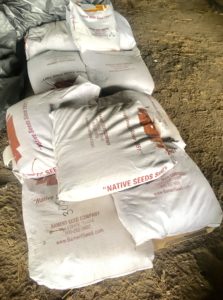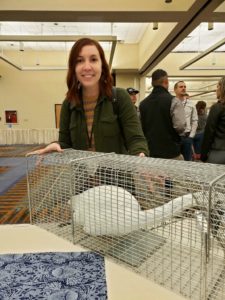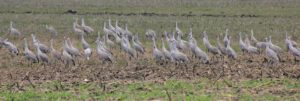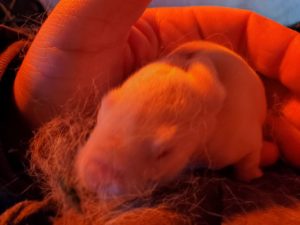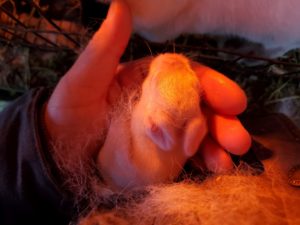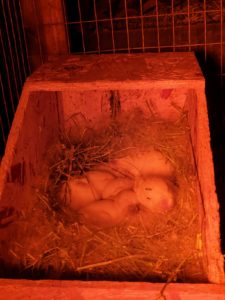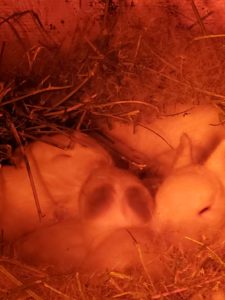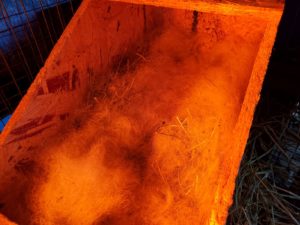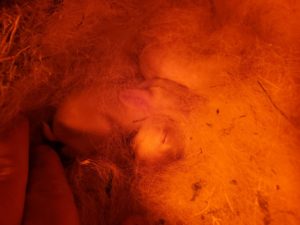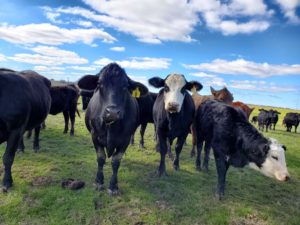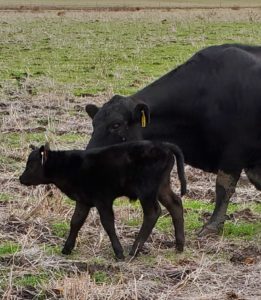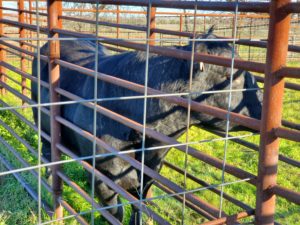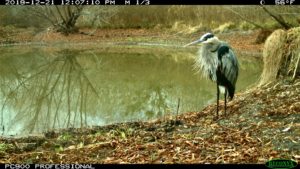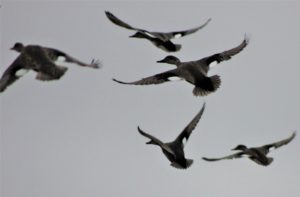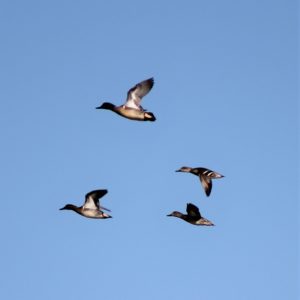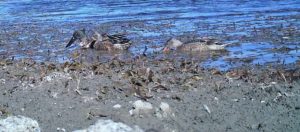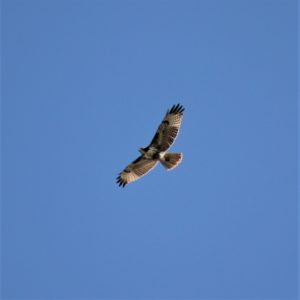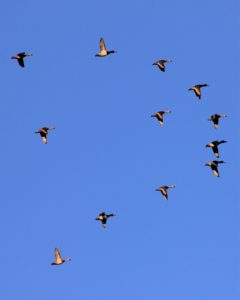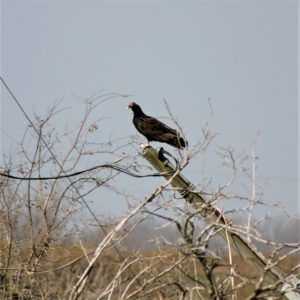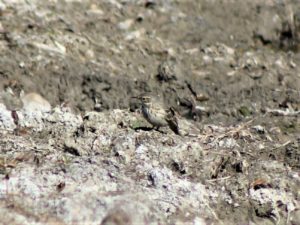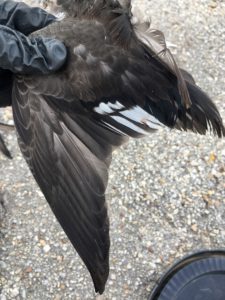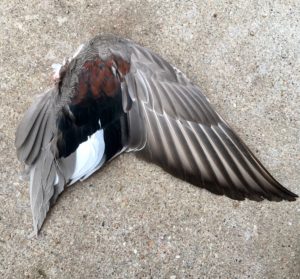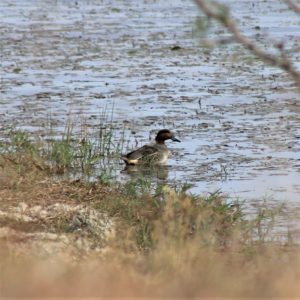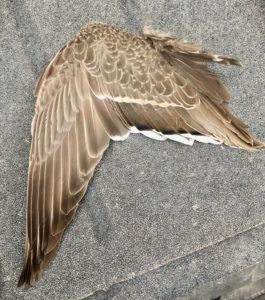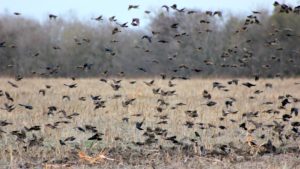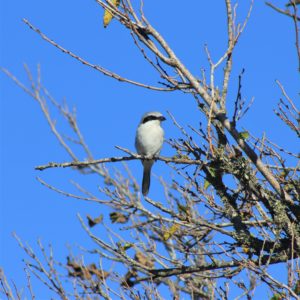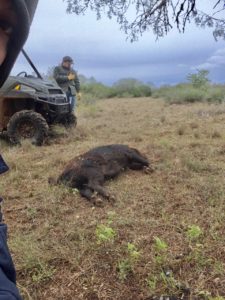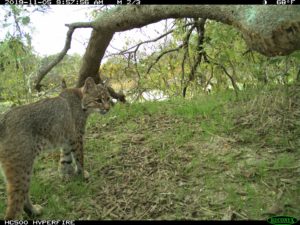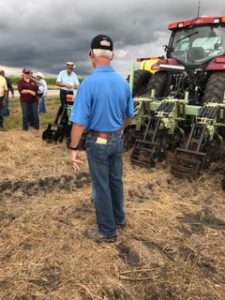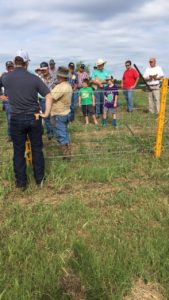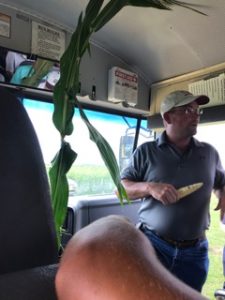https://texashelp.tamu.edu/coronavirus-information-resources/
Wildlife Intern Dani Miller
Weeks 39 & 40:
Two weeks ago, I moved the cows between pastures for the first time, and luckily, the ladies were obliging that morning and followed the truck into the adjacent pasture for a cotton seed treat. This removed them from the PUB project area (see photo) in advance of a final application of Roundup, which should take place within the next week unless the weather temporarily foils our plans again. The wait between cattle removal and herbicide application, in conjunction with the warmer weather, is expected to allow johnsongrass (Sorghum halepense) and other fast-growing invasives a little time to sprout up so they can be most effectively removed by the subsequent chemical application. One week post-application, we plan to plant the native seed blend, depending on weather conditions, using a TPWD-provided seed drill that is designed to plant the “fluffy” seed of native grasses and forbs. I look forward to receiving instruction on its use and then proceeding with planting.
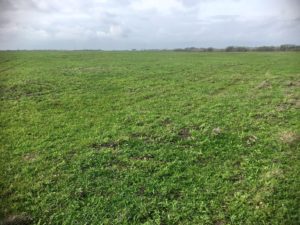
I also had my first experience using the disk under the guidance of one of the farm’s employees, Bobby. He and I were able to disk most of the Partners project’s fire break (see photo), though the soil of one area was still too wet and that section will have to be shredded instead. Everything is now in place for the burn, so we are just waiting on the right weather conditions, with specific attention placed on wind speed and direction, temperature, and humidity.
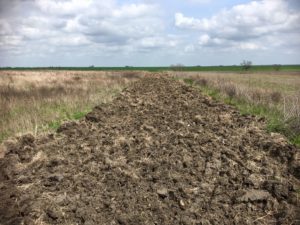
Last week, I received training on how to cut-stump mesquite, using a chainsaw to cut down a tree as close to the ground as possible and then immediately applying the recommended mix of triclopyr ester-based herbicide (in our case, Remedy Ultra) and diesel via a backpack sprayer to the surface of the remaining stump, ensuring that the root collar area, sides of the stump, and the cut surface, including the cambium, is completed coated so as to prevent resprouting. We will be cut-stumping trees in the LIP project area that were either outside the zone of the aerial spray or were only partially killed by the aerial spray (these trees were marked with orange spray paint prior to full leaf loss due to winter freezing).
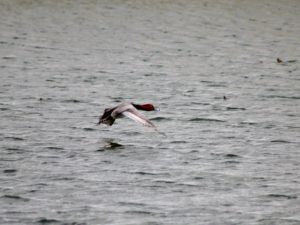
Recently, our farm intern, Randy, spotted an owl in an old culvert on property, so Dr. Tomeček and I visited the site and were able to confirm the presence of a burrowing owl (Athene cunicularia)! This is the second burrowing owl sighting on property, which is very exciting. Good spotting, Randy! I’ve also included a photo of a juvenile fulvous harvest mouse (Reithrodontomys fulvescens) that belonged to a litter sheltering under one of my coverboards, as well as an apache jumping spider (Phidippus apacheanus) who was hiding out in the casing brackets of a trail camera. Lastly, I spotted a flock of redheads (Aythya americana) visiting one of our ponds last Friday and managed to photograph this drake upon departure.
Until next time,
Dani Miller
Wildlife Biologist
Stiles Farm Foundation
Texas A&M AgriLife Extension
Dani Miller Wildlife Biologist
Weeks 37 & 38:
It’s been a busy February, with both TPWD Pastures for Upland Birds (PUB) projects as well as the USFWS Partners for Fish and Wildlife project moving forward in preparation for major management actions. The native seed blends for the PUB projects has been delivered (photo included), and the final application of Roundup is on the books to clear the way for planting the native grasses on our two sites at the farm. The Partners project is nearly ready for the prescribed burn, as we are just waiting on the ground to dry out enough to shred a fire break strip (disking the fire break would be ideal, but that site has historically been non-productive agriculturally due to its tendency to stay wet). In the interim, I have been working to provide notification of the plan to all relevant organizations and personnel. This event will be an initial step in restoring the area to native grassland habitat, as well as a demonstration of the prescribed burn process and protocols in the Blackland Prairie. These next stages for all three project areas should occur within the next month, so I look forward to reporting on our progress soon.
In mid-February, I attended the Texas Chapter of The Wildlife Society’s annual conference with Dr. Tomeček and the students of his lab. I was thrilled to be present for Dr. Tomeček’s acceptance of his new role as president of the chapter as well as the excellent research presentations given by two of his students. The conference experience also provided me an invaluable opportunity to meet other professionals and students in the field and learn about some of the current studies taking place within the state. Overall, I found the event to be informative, interesting, and productive to facilitating networking as I look forward to my next steps following the conclusion of my year here at the farm. Speaking with and listening to presenters and other attendees reinvigorated my own interest in research, and I am now looking into options for pursuing a master’s degree, with specific focus on human dimensions studies.
On another note, thanks to a fun raffle at the conference, I unexpectedly became the proud new owner of a Tomahawk box trap and two egret decoys. I have included pictures of my prizes upon collection, the latter of which I now share with Alex, Dr. Tomeček’s newest graduate student (photo credit to Amanda Hackney, raffle organizer extraordinaire). The egrets are currently inhabiting my yard as I attempt to coax any of the loquacious sandhill cranes foraging nearby to investigate, with a trail camera at the ready.
Until next time,
Dani Miller
Wildlife Biologist
Stiles Farm Foundation
Texas A&M AgriLife Extension
Randy Madewell Spring Farm Intern -Rabbits
So, it’s been a rather cold, wet week so I haven’t been able to spend a lot of time with my rabbits. The hardest thing that I’ve found with rabbits is that they’re so darn cute, I don’t want to get rid of them. One of my rabbits had a litter this week and they are doing good. She had eight little Californian kits (baby bunnies) that are just adorable with their “honeybun ears” as my wife refers to them. And, I must admit, she kind of has a point. My daughter said their little noses sticking up out of the bedding looks like a pig nose.
Rabbits kindle (give birth) between 28 and 35 days after breeding. So, on day 26 or 27 I put a nesting box in their cage with them along with some nesting material. I used alfalfa hay because that’s what I had on hand.
When the doe (female) is ready to give birth, they will start pulling hair from all over their body. Don’t worry, they have a special undercoat for this purpose. They will dig a hole in the back of the nesting box and stuff this hair in that hole. This creates a nice little hidey hole for the kits to stay warm and not be able to venture very far.
Kits are born with their eyes and ears closed, so any kind of movement in their vicinity gets them amped up thinking it’s mom coming home to feed them. Mother rabbits don’t hang out with their offspring once they are born. Their primary job is to make sure they are safe at birth, then they come back once, maybe twice, a day to feed them. I will continue to keep you posted as their development progresses.
Randy Madewell Spring Intern
Dani Miller Wildlife Biologist
Week 34:
We recently had site visits by Texas Parks & Wildlife (TPWD) personnel to assess the next steps for managing our Landowner Incentive Project (LIP), Pastures for Upland Birds (PUB), and USFWS Partners for Fish and Wildlife project areas. Our 2 PUB areas have been sprayed and disked enough that they should be ready for planting with the native grasses seed mix in early spring, after a period of grazing on one and another round of spraying on each to keep the introduced species in the seed bank from outcompeting the natives in the early stages of growth. The LIP area will need to be separated into 2 different cycles at this point, as the northern half is mostly clear of mesquite, allowing for equipment access and subsequent habitat manipulation, but the southern end will need another year’s delay to provide time for mesquite cut-stumping and bulldozing, for effective removal. The next stage for the Partners project is a prescribed burn, for which the TPWD regional fire manager is now developing a burn plan after conducting his site visit. Once the ground is dry enough, I will be disking a strip along the southern border of the area to create a fire break between it and the hay fields. Interestingly, the general rule of thumb for a fire break is that it be twice as wide as the grass is tall, so a 6-foot wide strip of bare ground will be more than adequate. As the other borders of the project area are adjacent to bare crop fields, that will conclude site prep in advance of the burn, so we will just need to wait on appropriate weather conditions, as determined by TPWD. Following the burn, we will begin building the walking trail, preparing other components of the infrastructure for installation, and of course planting the native seed mix, as progress in the development of the site as a Blackland Prairie nature education resource for the local community.
In late January, I accompanied Dr. Tomeček and his students to the East Foundation in South Texas for the lab’s annual coyote capture, for the purposes of collaring a sample of the local population to track their movements over one year. I had the fantastic opportunity to participate as part of the ground crew, which processed and released each coyote after they have been captured with a net gun via helicopter. With the combined efforts of 20 dedicated personnel, we collared and released 31 coyotes in a day and a half, which is a wonderful new record for the project. I look forward to sharing more details and photos about the experience in a future post.
To provide a few eyecatchers for this post, I’ve included a selection of trail camera photos I’ve collected since the last update. The American wigeons finally made an appearance in significant numbers in late December, with ring-necked ducks, gadwalls, green-winged teal, redheads, and northern shovelers as regular guests as well. I’ve also had some otter activity at multiple ponds, along with our local great blue herons, great egrets, and assorted shore birds including killdeer, greater yellowlegs, and Wilson’s snipe.
Dani Miller
Wildlife Biologist
Stiles Farm Foundation
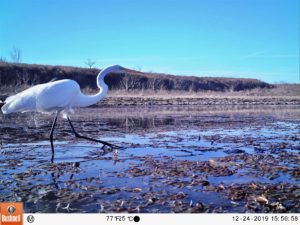
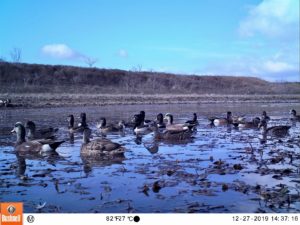
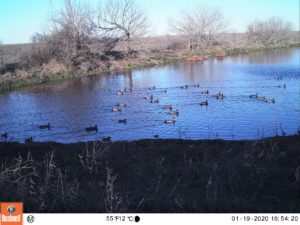
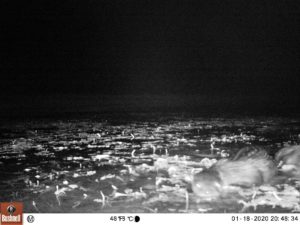

Wildlife Biologist Dani Miller
Recently, I assisted Dr. Tomeček in assembling a BoarBuster pig trap off-property. It was an involved process, but the mechanics of it were very interesting. It operates as a remotely-triggered drop-trap that, when set, is completely lifted off the ground by 3 legs connected to an inner ring. When triggered, an outer ring drops to the ground by way of diagonal rollers to trap the pigs. Once the pigs are removed, the outer ring is winched back to the up/set position. The trap can be observed via live feed by way of a motion-activated camera that notifies a person through a phone app, through which the trap can also be triggered to drop. Dr. Tomeček will be scrutinizing the qualities of this trap as compared to other types, with regards to effectiveness in trapping pigs (quantity/frequency), cost, time commitment to assembly and maintenance, longevity, and other related attributes that might concern a landowner when making pig-related damage management decisions for their property.
To start the new year, I’ve included recent photos of a few of the more commonplace sights around the farm this winter, though the subjects are no less interesting for their familiarity. Please enjoy a juvenile red-tailed hawk in flight and an adult with questionable choice in perches, a turkey vulture waiting its turn for a meal of ripe opossum, a trail camera capture of a northern shoveler drake and two hens, and a flock each of our three most abundant waterfowl species on the farm this season: gadwall, ring-necked duck, and green-winged teal. I will check back in soon with details on upcoming mesomammal trapping efforts.
Dani Miller
Wildlife Biologist
Stiles Farm Foundation
Wildlife Biologist Dani Miller
Weeks 25 & 26:
As the farm only participates in the first split of the public waterfowl hunting season, which ended on December 1st, I can now provide this year’s final tally! A total of 97 harvested birds was reported via wing collection, from which I’ve sourced a few photographed specimens, including a gadwall drake wing, a northern pintail hen wing, and a bufflehead hen wing. Harvested species included ring-necked duck, gadwall, canvasback, northern shoveler, green-winged teal, lesser scaup, mallard, bufflehead, northern pintail, American wigeon, ruddy duck, and American coot. This is an exciting range of species, particularly because lesser scaup, bufflehead, northern pintail, and ruddy duck had not yet been sighted in visual surveys this season, which points to the importance of reporting by hunters as a supplementary source of data for biologists and land managers. I even had one friendly neighborhood hunter (photos cropped for anonymity) show off his take of the day, a canvasback drake, at one of my trail cameras. Cheers, mate!
I am conducting a small mammal survey this week into next at one of the four 400-meter transect lines established on the farm, and will be running 80 Sherman traps, with 2 placed every 10 meters, over 7 nights, for a total of 560 expected trap-nights (counted as the number of traps set multiplied by the number of nights deployed; used as a means of measuring effort during the sampling period). My predecessor ran surveys at these four lines at intervals from late fall into spring, and I will be following her design to continue the collection of comparable data on an annual basis. The traps are set near dusk and checked beginning at daylight. When an animal, such as a small rodent, is captured, the animal is moved from the trap into a gallon-sized Ziploc and corralled into a corner so its species and sex can be determined and the lengths of its body, tail, and hind foot can be measured while it lies flush along the bottom of the bag. The animal is then released, and the next trap is checked. I should have a few photos from this first survey for my next post.
I’ve included a few fall migration photos from around the farm, including a mixed cloud of red-winged blackbirds and brown-headed cowbirds, a perched loggerhead shrike, a green-winged teal drake at rest, and a new species for the farm’s roster, the American pipit.
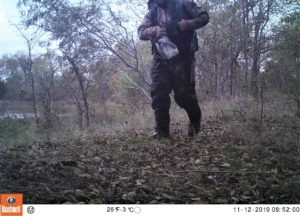
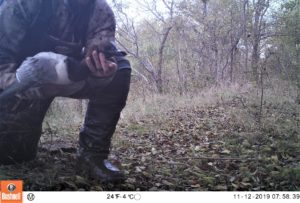
Until next time,
Dani Miller
Wildlife Biologist
Stiles Farm Foundation
Wildlife Biologist Dani Miller at Stiles Farm
Weeks 23 & 24:
The feral hog aerial gunning in South Texas a few weeks ago was unfortunately cut short due to helicopter malfunction, so we only had a total of 34 carcasses provided this round to attract the local coyote population and other scavengers. We set cameras on 6 kill sites during that first morning’s shoot, as we expected to have more opportunities that afternoon and the following day. After learning that was not to be the case during the course of the second morning, we revisited most of our previous day’s sites and set cameras on another 2 carcasses. In doing so, we discovered something interesting: every pig carcass without a camera that we located (4) had been found by scavengers and largely consumed overnight, but those with cameras that we revisited (4) were virtually untouched, though evidence of discovery by one or more coyotes was present at one of the carcasses due to circling tracks and very minor damage to the carcass. This dichotomy, even with such a small sample size, begs the questions of if and how the cameras might be affecting site use by some or all scavengers. It will be interesting to see if this lack of, or delay in, scavenging will be observed in the GPS data on collared coyotes in the concurrently active broad-scale coyote study, as well as in this event’s associated camera data, to be collected on the next visit to the project area. I’ve included a photo from the trip that shows me using a trick I learned from Dr. Tomeček regarding testing the trail camera view of the intended area or subject matter. In order to determine if the trail camera setup is ideal, reverse the camera on your phone to the front-facing ‘selfie’ mode, then line it up with the camera’s lens while your phone is pressed flush against the trail camera’s casing and take a photo. You can then assess if you need to adjust the camera height, angle, and/or direction in order to capture the entire desired viewing area, or in our case a few times, just move the pig.
I thoroughly enjoyed this experience and appreciated the opportunity to participate in an aerial gunning operation as part of the ground crew, which also included Dr. Tomeček and two Wildlife Services employees, all of whom expertly coordinated with the skilled team of the Wildlife Services helicopter pilot and gunner to determine search patterns, spot live pigs, and locate downed pigs. I was also shown how to pull a blood sample from behind the eye of a pig carcass using a spinal tap needle, rather than from the heart, which is the traditional source but often less reliable due to bullet penetration and consequent blood loss. I successfully filled a syringe on my second attempt, the product of which will be submitted for testing along with the other blood samples taken by the Wildlife Services personnel, in order to determine if the sampled pigs were carrying any diseases.
I do not have a surplus of photos from the trip, so I have attached a few more recent trail camera photos from around the farm, including a rare daytime bobcat sighting, an updated shot of the curious raccoon kits that frequent one of the camera sites, and a nine-banded armadillo in an instant of stillness. Additionally, this somewhat chilled diamondback rattlesnake was discovered holed up along a fence line that needed work and was relocated elsewhere on the property, away from human activity.
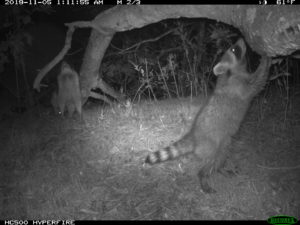
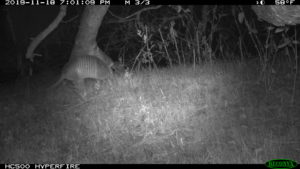
Later this week, I will provide some information on small mammal trapping surveys, which will be conducted soon. I will also have the final tally of the reported harvest for our public duck hunting season, as the the farm only participates in the first split.
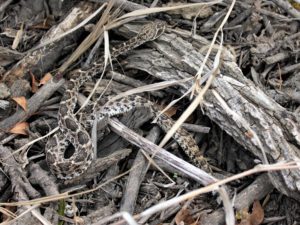
Until next time.
Dani Miller
Wildlife Biologist
Stiles Farm Foundation


